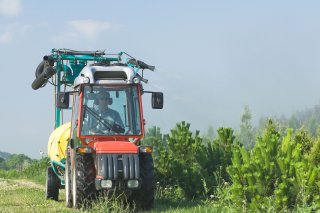Land
We depend upon clean land for necessities including food, shelter, and energy. Land is not only where we live but it also provides habitat for plants and animals.
Land Pollution Impacts

Impacts of Land Pollution to Humans
Human health can be impacted from exposure to toxic chemicals and pesticides used or disposed of on land.
The health effects of pesticides can vary. For example, some affect the nervous system while others may irritate the skin or eyes. Some pesticides may be carcinogens. Others may affect the hormone, or endocrine, system in the body.
Some chemicals or substances left in the environment as a result of past human activity can contaminate sites and may be hazardous to human health. For example, lead, a common environmental contaminant, can be harmful to humans (particularly children) when ingested or inhaled.
Impacts of Land Pollution to Animals and Plants
Chemicals used or disposed of on land can affect plants and animals much like they affect humans. Like humans, animals may experience health problems if exposed to toxic chemicals.
For example, pesticides can harm wildlife including endangered species and pollinators when not used properly.
Contaminated soils can leach toxic chemicals into nearby ground or surface waters, where they can be taken up and accumulated by plants and animals, and then ‘biomagnify,’ or concentrate, up the food chain.
EPA Actions on Land Pollution
EPA, state, and local partners have made progress in preventing pollution and cleaning up the land under multiple statutes. Several examples are listed below.
This benefits not just human health, but animal, plant, and ecosystem health.
Clean Land Successes

Under the pesticide laws including the Federal Insecticide, Fungicide, and Rodenticide Act (FIFRA), EPA:
- Protects human health and the environment through careful evaluation of human and ecological risks from exposure to pesticides through the registration process.
- Protects workers who may be exposed to pesticides as part of their job including agricultural workers and pesticide handlers through the Worker Protection Standard (WPS).
- Protects wildlife, including federally listed endangered and threatened species through the Endangered Species Protection Program and pollinator protection.
Under the amended Toxic Substances Control Act (TSCA), EPA works to:
- Minimize exposure to chemicals that harm human health.
- Prevent contamination to the environment that negatively impacts ecosystems.
- Read more information about recent TSCA milestones
Under the Comprehensive Environmental Response, Compensation, and Liability Act (CERCLA), EPA:
- Protects public health through cleanups of some of the nation’s most contaminated land.
- Improves infant health by reducing the incidence of birth defects.
- Reduces blood lead levels in children through cleanups of lead contaminated sites. For more information on accomplishments like these, see Office of Land and Emergency Management Program Benefits.
- Promotes ecological revitalization, which improves soil health, supports diverse vegetation, sequesters carbon, and sets the stage for wildlife habitat and recreation opportunities for humans in nature.

Under the Resource Conservation and Recovery Act (RCRA), EPA:
- Protects public health and ecosystems through controlling human exposure to hazardous and non-hazardous waste.
- Restores millions of acres of contaminated lands, making the land ready for productive reuse through the RCRA Corrective Action program. Learn more about RCRA and Hazardous Waste Cleanups
- Protects groundwater, the source of drinking water for nearly half of the United States, through the Underground Storage Tanks (UST) Prevention Program.
Under the Emergency Planning and Community Right-to-Know Act (EPCRA), EPA:
- Significantly improves community preparedness for potential chemical emergencies.
- Increases public knowledge and access to chemical information from facilities via the Toxic Release Inventory (TRI) for communities.
- Tracks waste management of chemicals that cause significant adverse acute human health and environmental effects.
These highlights are just some examples of preventing pollution or cleaning up the land. EPA is working to protect the health of all Americans, as well as, plants and animals in our shared environment.
